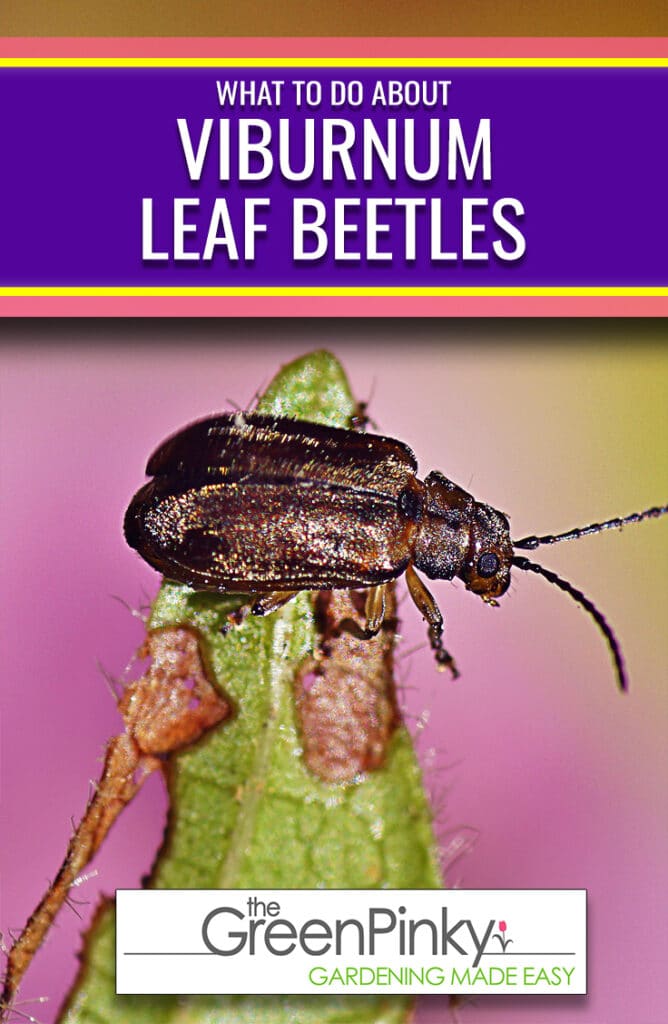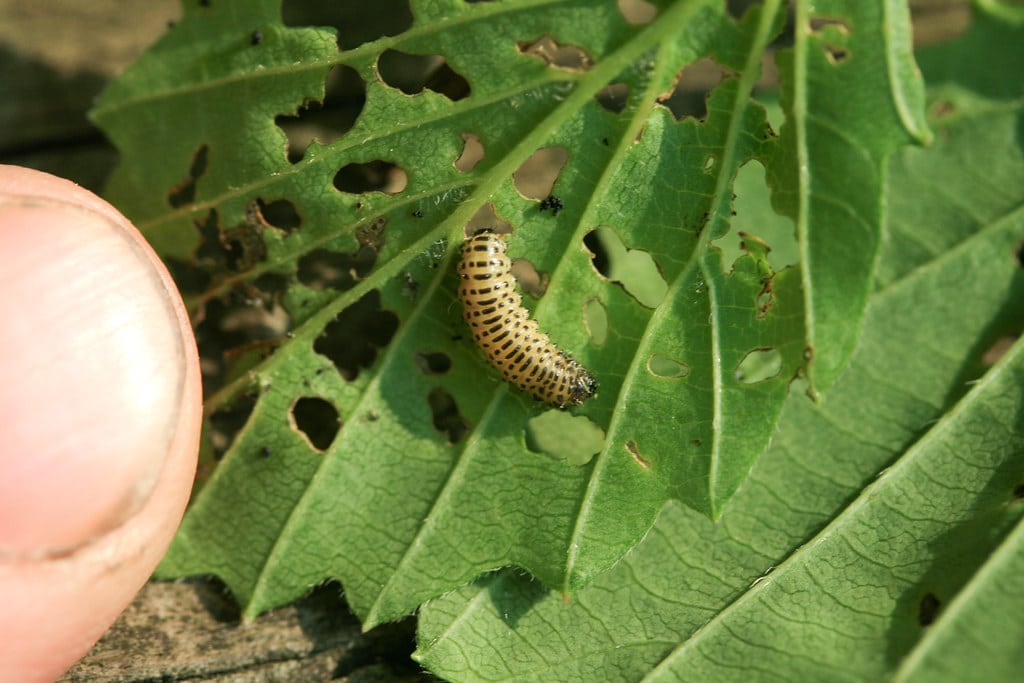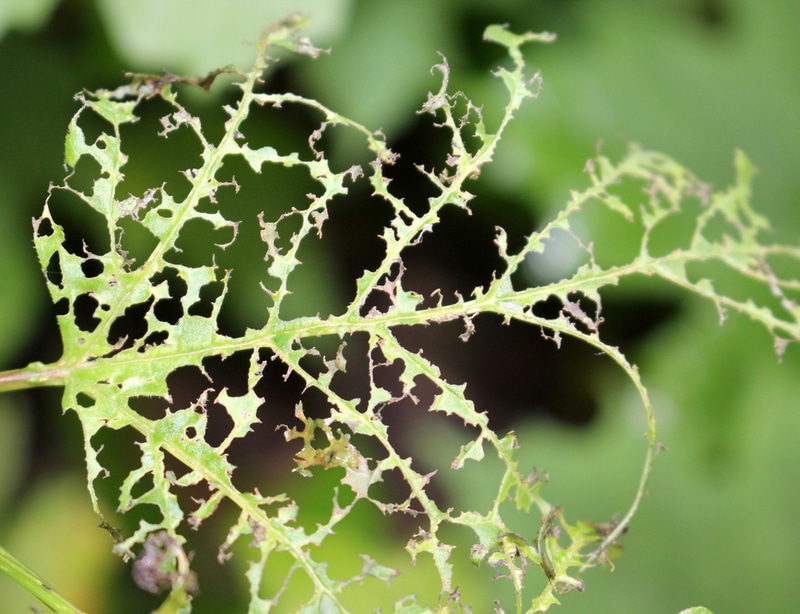What’s eating my viburnum? What’s chewing holes in the leaves? It’s viburnum leaf beetles – Pyrrhalta viburni.
Both the larvae and the adults feed on the leaves of viburnums but at different times during the growing season.
These insects are heavy feeding, which can defoliate a shrub and never give it time to recover. If feeding is allowed to continue unchecked, you could lose your shrub.
This European native was first found in the United States in New York in 1996. They are now found scattered across the northeast United States and southern Canada.
Here’s what you need to know to combat this pest and save your viburnums.
You may also be interested in checking our article on cottonwood trees.

Life Cycle
Thankfully, they only have one generation per year.
Eggs overwinter in slender stems and larvae hatch out in early to mid-May. They feed for about a month, growing larger with each molt, and then crawl down the shrub to pupate in the soil.
Adults emerge in late June or early July and also feed on the leaves.
Females lay their eggs in the ends of twigs. She chews a hole in a stem, deposits 5 or 6 eggs in it, then covers the hole with a plug of chewed bark and excrement. These holes are arranged in a line down the underside of the twig. These egg laying sites are very distinctive and easy to find. Each female can lay up to 500 eggs in her lifetime.

These eggs need a period of cold weather to develop. Therefore, shrubs in warmer climates should not be troubled by this pest.
Identification
Adult beetles are small and brown with gold hairs on their bodies. They are only ¼ inch long and often overlooked.

Larvae will grow to about ⅓ inch long and have black dashes and dots on their brown or yellow-green bodies. They are very tiny when they hatch, but go through 3 molting stages as they develop. With each molt, they grow larger.

Damage Identification
Both the larvae and the adults chew holes in the leaves, but at different times of the year. Larvae attack in the spring, and adults later in the summer. As they chew, they create skeletonized leaves.
The damage resembles the damage caused by Japanese beetles, but larval feeding damage occurs well before Japanese beetles are wreaking havoc. Larvae feed on the underside of leaves, usually in a group.
You will see more feeding damage on viburnums that are grown in the shade.

Prevention
The best way to prevent this pest from attacking is to plant the less susceptible varieties. Viburnum leaf beetles have favorite varieties (they seem to prefer smooth leaves over fuzzy ones), and Dr. Paul Weston at Cornell University in Ithaca, New York, has compiled a list of susceptible plants.
But what if you already have a susceptible viburnum, or a beautiful hedge of arrowwoods? Let’s look at some methods of control.
Control
Now that you know the life cycle of these pests, and you know what to look for, you can begin scouting for egg laying sites in winter and for tiny larvae in spring before damage gets severe.
Cultural Controls
Planting resistant varieties and scouting – looking for problems before they get out of hand – are your best cultural controls. Keeping your plants healthy to recover from attacks is important, but beware of over-fertilizing. You might be creating a delicious buffet of tender new growth!

If you enjoyed this article, you may also be interested in our article about what to do about fleas that are on your lawn.
Mechanical Controls
The best way to get rid of them is to prune out the egg laying sites. Once you know what they look like, these sites are very easy to spot.
Just cut the twigs off and dispose of them. Don’t compost them or leave them lying on the ground. This will significantly reduce the number of beetles you’ll have in your yard next year.
And while this can be a tedious winter garden chore, the more twigs you can trim, the fewer larvae – and fewer beetles – you will have next year. Pruning can be done from October through March.
These insects do not drop to the ground to pupate. Instead, they crawl down the plant. Using a product like Tanglefoot can stop them from reaching the soil to pupate.
Biological Controls
Ladybugs, soldier bugs, green lacewings, and assassin bugs all eat viburnum beetle larvae and some of these beneficial predators eat the adults, too.
To encourage these natural predators, limit pesticide use. A chemical pesticide can’t tell the difference between a beneficial insect and a pest. And some products are more damaging to the beneficial insects than they are to the “bad guys.”
Chemical Controls
Chemical control should be your last resort. Do not use a broad-spectrum insecticide. This type of product kills all insects, including the beneficial ones. That can make your problem worse!
Spraying horticultural oil on twigs where eggs have been laid will prevent them from hatching.
Insecticidal soaps and spinosad will kill the larvae but are not effective when dealing with adults. Both of these products need to come in contact with the larvae for them to be effective. Treat larvae when they are small before they have a chance to do much damage. And smaller larvae are more susceptible to contact insecticides.
A systemic insecticide can be applied as a soil drench before the adults emerge. This type of product is taken up by a plant, making it poisonous to the insects that feed on it. Systemic insecticide does not kill the pupae in the ground, instead, it poisons the leaves so that when the beetles begin feeding again, it kills them. Do not use a systemic when the flowers are in bloom, as it will also kill foraging bees.
Proper Reporting
Viburnum leaf beetles are considered a relatively “new” pest in the United States and Canada. They have been found in the following states and provinces:
- Maine, New Hampshire, Massachusetts, New York, New Jersey, Maryland, Pennsylvania
- Illinois, Indiana, Michigan, Ohio, Wisconsin
- British Columbia, New Brunswick, Ontario, Prince Edward Island, Quebec
These states and provinces are monitoring this pest; you can contact your extension service for more information and to report activity. If you live outside these areas and you find viburnum leaf beetles, do report it to your local extension service or farm bureau.


These insects primarily attracted to nanny berry bushes in my area,defoliating them completely some years. Nannies are tough bushes but die off in marginal habit. All kinds of wildlife use Nannies for cover especially during winter months.